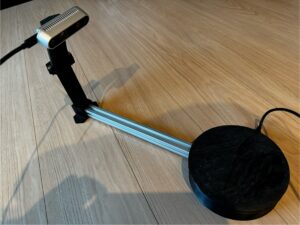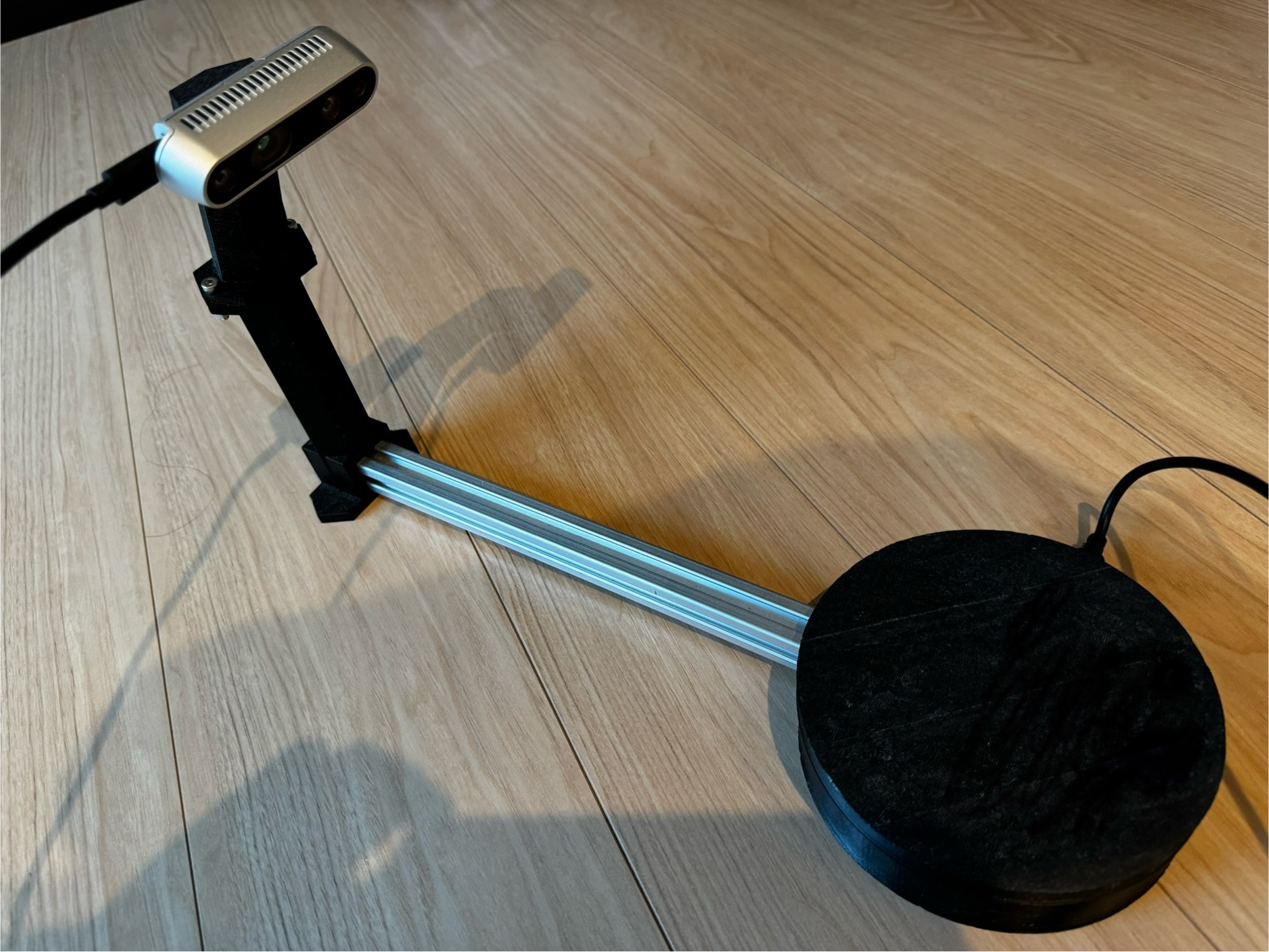あわせて読みたい


Reverse Engineering Project Part1(立ち上げ編)
リバースエンジニアリングに興味が出てきたので、自分で製作できないか調査していた。そんな中、以下のWebsiteに同様の簡単そうなプロジェクトがあったので、まずはマネ...
上記で記載したように3Dスキャナの立ち上げを行った。試しに使用している最中にいくつかスキャナの性能があまり出ないので工夫ができないか検討してみることにした。一番下にオリジナルのソースコードを記載したので参照してほしい。
目次
改善検討1:取得した3Dデータのマージ方法
オリジナルコードのprocessFoto()関数を見てみよう。
self.main_pcd = self.main_pcd + self.pcd
詳細ソースは下記ののオリジナルコードで見て頂きたいが、ここではステージを回転させながら各ステージ回転角度で取得した3Dデータ点群を単純に足し合わせている。その点群データを用いて、makeSTL()関数で余分なゴミの点群を除去してSTLに変換している。
ここでの問題は物体が回転対称性に近くなく、または、ステージ上の回転中心に配置できなければ、ステージ上に載せた物体を各回転角でスキャン取得した点群データを単純に足し合わせると、
そこで、特にこのマージ方法をステージ回転角ごとの点群を単純和にするのではなく、点群のマッチングをとって合成する方が精度よく合成できるのはないかということでその検討を行った。
適用したのが、RANSACとICPである。自分のコードでは、以下に変更し、Register()関数の部分でそれを記載している
#Ransac and then ICP fitting
if angle < 0.1:
self.main_pcd = self.pcd
else:
#Ransac estimation
voxel_size = 0.005 # means 5mm for this dataset
trans = self.register(self.main_pcd, self.pcd, voxel_size)
self.main_pcd.transform(trans)
self.add_color_normal(self.pcd)
self.main_pcd = self.merge([self.main_pcd, self.pcd])RANSAC and ICP
- RANSACとは、RANdom SAmple Consensusの略で、ロバストなモデル推定のアルゴリズムである。
(ロバスト推定とは与えられた観測値に外れ値が含まれているとして、その影響を抑えることを目的とした推定)
処理の手順は、- ①データからランダムに数点を抽出する
- ②誤差がしきい値以下であればそのモデルを正しいモデル候補に追加する
- ③抽出したデータを元に最小二乗法などで仮のモデルを推定し、そのモデルと全体の誤差を求める
- ④仮のモデルからの距離がしきい値以下のデータ点をインライア(inlier: 外れ値でないデータ)とする
- ⑤インライアの数がしきい値以上、または既定の回数に達するまで上記の手順を繰り返す
- ICPとは、Iterative Closest Point(ICP)は、3D点群の注目する点に最も近い点を求めるアルゴリズムです。このアルゴリズムは、2つの点群の間で最適な位置関係を見つけるために使用されます。
処理の手順は、- ①初期位置として、両方の点群を重心に配置します。
- ②参照点群から最も近い点を探すことにより、注目する点群を更新します。
- ③参照点群と注目する点群の間で対応する点を定義します。
- ④対応する点を使用して、注目する点群を回転、平行移動することで最適な位置を見つけます。
- ⑤更新された位置に基づいて、操作を繰り返します。
- ⑥ある停止条件(例えば変化量が一定以下になったとき)が満たされるまで繰り返します。
とりなります。要はRANSACでラフにモデル推定を行って、ICPで最終的なモデルフィットを行う。
#Ransac and IPC model fitting
def register(self, pcd1, pcd2, size):
# Position alignment between two point clouds
kdt_n = o3d.geometry.KDTreeSearchParamHybrid(radius=size, max_nn=50) # 50
kdt_f = o3d.geometry.KDTreeSearchParamHybrid(radius=size * 10, max_nn=50) # 50
# Downsampling
pcd1_d = o3d.geometry.PointCloud.voxel_down_sample(pcd1, size)
pcd2_d = o3d.geometry.PointCloud.voxel_down_sample(pcd2, size)
o3d.geometry.PointCloud.estimate_normals(pcd1_d, kdt_n)
o3d.geometry.PointCloud.estimate_normals(pcd2_d, kdt_n)
# o3d.visualization.draw_geometries([pcd1_d], "down sampling")
# o3d.visualization.draw_geometries([pcd1_d, pcd2_d],"result_original")
# Feature amount cal
pcd1_f = o3d.pipelines.registration.compute_fpfh_feature(pcd1_d, kdt_f)
pcd2_f = o3d.pipelines.registration.compute_fpfh_feature(pcd2_d, kdt_f)
# Preparation
checker = [o3d.pipelines.registration.CorrespondenceCheckerBasedOnEdgeLength(0.9),
o3d.pipelines.registration.CorrespondenceCheckerBasedOnDistance(size * 0.2)]
est_ptp = o3d.pipelines.registration.TransformationEstimationPointToPoint()
est_ptpln = o3d.pipelines.registration.TransformationEstimationPointToPlane()
criteria = o3d.pipelines.registration.RANSACConvergenceCriteria(max_iteration=5000000,
confidence=0.99) # max_validation=500
# Multi-times RANSAC Matching
iternum = 0
fitness1 = 0
thresold = 0.65 # fitness
while fitness1 < thresold and iternum < 10:
result1 = o3d.pipelines.registration.registration_ransac_based_on_feature_matching(
pcd1_d, pcd2_d,
pcd1_f, pcd2_f,
mutual_filter=True,
max_correspondence_distance=size * 2, # 2
estimation_method=est_ptp,
ransac_n=4,
checkers=checker,
criteria=criteria
)
fitness1 = result1.fitness
# print("result1", result1)
print("fitness", fitness1, "iternum", iternum)
iternum += 1
if iternum > 9: #ignore and eliminate the scanned information
self.pcd = o3d.geometry.PointCloud()
# break
# Modifying slightly by ICP
result2 = o3d.pipelines.registration.registration_icp(pcd1, pcd2, size, result1.transformation, est_ptpln)
# o3d.visualization.draw_geometries([pcd1_d, pcd2_d.transform(result1.transformation), pcd2_d.transform(result2.transformation)], "result_ransac_ICP")
return result2.transformation実行結果(新旧コードの比較)
オリジナルソースコード
# -*- coding: utf-8 -*-
"""
Created on Thu Jan 21 16:38:24 2021
@author: wouter
"""
# https://stackoverflow.com/questions/7546050/switch-between-two-frames-in-tkinter
# https://stackoverflow.com/questions/14817210/using-buttons-in-tkinter-to-navigate-to-different-pages-of-the-application
# pyinstaller.exe --onefile --windowed --icon="E:/Documenten/3D-scanner/Arduino/icoontje3dscan_WDJ_icon.ico" E:/Documenten/3D-scanner/Arduino/DraaischijfMainV4.py
import serial # pip install pyserial
import keyboard # pip install keyboard
import pyrealsense2 as rs
import open3d as o3d # pip install open3d
import numpy as np # pip install numpy
import time
from tkinter import font as tkfont
import tkinter.filedialog
import tkinter as tk
from PIL import ImageTk
from PIL import Image
import ast
from tkinter.ttk import Progressbar
class Arduino():
def __init__(self, comPort, baudRate, timeout):
self.comPort = comPort
self.baudRate = baudRate
self.timeout = timeout
self.totalAngle = 0
self.s = serial.Serial(self.comPort, self.baudRate, timeout=self.timeout)
time.sleep(2)
self.currentstep = 0
def rotate(self, steps):
self.steps = steps
self.negative = int(self.steps < 0)
if self.negative:
self.steps = -self.steps
self.stepsAsString = str(self.steps)
self.s.write([self.negative])
for i in range(5 - len(self.stepsAsString)):
self.s.write([0])
for i in range(len(self.stepsAsString)):
self.s.write([int(self.stepsAsString[i])])
def waitForRotation(self):
while True:
self.data = str(self.s.readline())
if self.data != "b''":
self.currentstep += self.steps
if int(str(self.data)[2:len(self.data) - 1]) != self.steps:
self.close()
raise Exception("The Arduino returned the wrong number of steps!")
break
def giveAngle(self):
self.gearRatio = 6
self.currentAngle = ((self.currentstep * 360) / 2048) / self.gearRatio
return self.currentAngle
def close(self):
self.s.close()
class Scan():
def __init__(self, width, height, framerate, autoexposureFrames, backDistance):
self.width = width
self.height = height
self.framerate = framerate
self.backDistance = backDistance
self.autoexposureFrames = autoexposureFrames
self.main_pcd = o3d.geometry.PointCloud()
self.pipe = rs.pipeline()
self.config = rs.config()
self.config.enable_stream(rs.stream.color, self.width, self.height, rs.format.any, self.framerate)
self.config.enable_stream(rs.stream.depth, self.width, self.height, rs.format.any, self.framerate)
# post-processing filters
self.depth_to_disparity = rs.disparity_transform(True)
self.disparity_to_depth = rs.disparity_transform(False)
self.dec_filter = rs.decimation_filter()
self.temp_filter = rs.temporal_filter()
self.spat_filter = rs.spatial_filter()
self.hole_filter = rs.hole_filling_filter()
self.threshold = rs.threshold_filter(0.17, 0.4)
self.dtr = np.pi / 180
self.distance = 0.258 - self.backDistance
self.bbox = o3d.geometry.AxisAlignedBoundingBox((-0.13, -0.13, 0), (0.13, 0.13, 0.2))
def startPipeline(self):
self.pipe.start(self.config)
self.align = rs.align(rs.stream.color)
print("pipeline gestart")
def stopPipeline(self):
self.pipe.stop()
self.pipe = None
self.config = None
print("pipeline gestopt")
def takeFoto(self):
print("foto gemaakt!")
for i in range(self.autoexposureFrames):
self.frameset = self.pipe.wait_for_frames()
# neem de foto
self.frameset = self.pipe.wait_for_frames()
self.frameset = self.align.process(self.frameset)
self.profile = self.frameset.get_profile()
self.depth_intrinsics = self.profile.as_video_stream_profile().get_intrinsics()
self.w, self.h = self.depth_intrinsics.width, self.depth_intrinsics.height
self.fx, self.fy = self.depth_intrinsics.fx, self.depth_intrinsics.fy
self.px, self.py = self.depth_intrinsics.ppx, self.depth_intrinsics.ppy
self.color_frame = self.frameset.get_color_frame()
self.depth_frame = self.frameset.get_depth_frame()
# self.depth_frame = self.threshold.process(self.depth_frame)
# self.depth_frame = self.depth_to_disparity.process(self.depth_frame)
# self.depth_frame = self.dec_filter.process(self.depth_frame)
# self.depth_frame = self.temp_filter.process(self.depth_frame)
# self.depth_frame = self.spat_filter.process(self.depth_frame)
# self.depth_frame = self.disparity_to_depth.process(self.depth_frame)
# self.depth_frame = self.hole_filter.process(self.depth_frame)
# self.depth_frame = self.depth_frame.as_depth_frame()
self.intrinsic = o3d.camera.PinholeCameraIntrinsic(self.w, self.h, self.fx, self.fy, self.px, self.py)
self.depth_image = np.asanyarray(self.depth_frame.get_data())
self.color_image = np.asanyarray(self.color_frame.get_data())
def processFoto(self, angle):
print(angle)
self.angle = angle
self.depth_frame_open3d = o3d.geometry.Image(self.depth_image)
self.color_frame_open3d = o3d.geometry.Image(self.color_image)
self.rgbd_image = o3d.geometry.RGBDImage.create_from_color_and_depth(self.color_frame_open3d,
self.depth_frame_open3d,
convert_rgb_to_intensity=False)
self.pcd = o3d.geometry.PointCloud.create_from_rgbd_image(self.rgbd_image, self.intrinsic)
self.pcd.estimate_normals(search_param=o3d.geometry.KDTreeSearchParamHybrid(radius=0.1, max_nn=30))
self.pcd.orient_normals_towards_camera_location(camera_location=np.array([0., 0., 0.]))
self.getcameraLocation()
self.rMatrix()
self.pcd.rotate(self.R, (0, 0, 0))
self.pcd.translate((self.x, self.y, self.z))
self.pcd = self.pcd.crop(self.bbox)
self.pcd, self.ind = self.pcd.remove_statistical_outlier(nb_neighbors=100, std_ratio=2)
self.main_pcd = self.main_pcd + self.pcd
def getPointcloud(self):
return self.main_pcd
def giveImageArray(self):
return self.color_image
def getcameraLocation(self):
self.x = np.sin(self.angle * self.dtr) * self.distance - np.cos(self.angle * self.dtr) * 0.035
self.y = -np.cos(self.angle * self.dtr) * self.distance - np.sin(self.angle * self.dtr) * 0.035
self.z = 0.165
self.o = self.angle
self.a = 112.5
self.t = 0
def rMatrix(self):
self.o = self.o * self.dtr
self.a = (-self.a) * self.dtr
self.t = self.t * self.dtr
self.R = [[np.cos(self.o) * np.cos(self.t) - np.cos(self.a) * np.sin(self.o) * np.sin(self.t),
-np.cos(self.o) * np.sin(self.t) - np.cos(self.a) * np.cos(self.t) * np.sin(self.o),
np.sin(self.o) * np.sin(self.a)],
[np.cos(self.t) * np.sin(self.o) + np.cos(self.o) * np.cos(self.a) * np.sin(self.t),
np.cos(self.o) * np.cos(self.a) * np.cos(self.t) - np.sin(self.o) * np.sin(self.t),
-np.cos(self.o) * np.sin(self.a)],
[np.sin(self.a) * np.sin(self.t), np.cos(self.t) * np.sin(self.a), np.cos(self.a)]]
def makeSTL(self, kpoints, stdRatio, depth, iterations):
# print(self.main_pcd)
self.stl_pcd = self.main_pcd
self.stl_pcd = self.stl_pcd.uniform_down_sample(every_k_points=kpoints)
self.stl_pcd, self.ind = self.stl_pcd.remove_statistical_outlier(nb_neighbors=100, std_ratio=stdRatio)
self.bbox1 = o3d.geometry.AxisAlignedBoundingBox((-0.13, -0.13, 0), (0.13, 0.13, 0.01))
self.bottom = self.stl_pcd.crop(self.bbox1)
try:
self.hull, self._ = self.bottom.compute_convex_hull()
self.bottom = self.hull.sample_points_uniformly(number_of_points=10000)
self.bottom.estimate_normals(search_param=o3d.geometry.KDTreeSearchParamHybrid(radius=0.1, max_nn=30))
self.bottom.orient_normals_towards_camera_location(camera_location=np.array([0., 0., -10.]))
self.bottom.paint_uniform_color([0, 0, 0])
self._, self.pt_map = self.bottom.hidden_point_removal([0, 0, -1], 1)
self.bottom = self.bottom.select_by_index(self.pt_map)
self.stl_pcd = self.stl_pcd + self.bottom
except:
print("No bottom could be made")
pass
finally:
self.mesh, self.densities = o3d.geometry.TriangleMesh.create_from_point_cloud_poisson(self.stl_pcd,
depth=depth)
self.mesh = self.mesh.filter_smooth_simple(number_of_iterations=iterations)
self.mesh.scale(1000, center=(0, 0, 0))
self.mesh.compute_vertex_normals()
return self.mesh
class App(tk.Tk):
def __init__(self, *args, **kwargs):
tk.Tk.__init__(self, *args, **kwargs)
self.title_font = tkfont.Font(family='Arial', size=18, weight="bold", slant="italic")
self.title("Boest 3D-Scanner")
# self.wm_iconbitmap('icoontje3dscan_WDJ_icon.ico')
self.iconbitmap(default='icoontje3dscan_WDJ_icon.ico')
self.resizable(False, False)
self.dictionary = self.readSettings()
container = tk.Frame(self)
container.pack(side="top", fill="both", expand=True)
container.grid_rowconfigure(0, weight=1)
container.grid_columnconfigure(0, weight=1)
self.frames = {}
for F in (StartPage, SettingsPage):
page_name = F.__name__
frame = F(parent=container, controller=self)
self.frames[page_name] = frame
frame.grid(row=0, column=0, sticky="nsew")
self.show_frame("StartPage")
self.frames["StartPage"].stlButton.configure(bg="#cccccc")
self.frames["StartPage"].saveButton.configure(bg="#cccccc")
self.frames["StartPage"].buttonShowPC.configure(bg="#cccccc")
self.enablePC = False
self.enableSaveSTL = False
def show_frame(self, page_name):
'''Show a frame for the given page name'''
frame = self.frames[page_name]
frame.tkraise()
def startScan(self):
self.ard = Arduino(str(self.dictionary["COMport"]), int(self.dictionary["baudrate"]), 0.1)
self.scan = Scan(int(self.dictionary["widthFrame"]), int(self.dictionary["heightFrame"]), 30, 10, 0)
self.scan.startPipeline()
self.frames["StartPage"].startProgress()
try:
while True:
self.scan.takeFoto()
self.frames["StartPage"].showImage(self.scan.giveImageArray())
angle = float(self.ard.giveAngle())
self.frames["StartPage"].Progress(angle)
self.ard.rotate(int(self.dictionary["stepSize"]))
self.scan.processFoto(angle)
self.ard.waitForRotation()
self.update()
if angle >= 360:
print("de cirkel is rond!")
self.frames["StartPage"].endProgress()
break
if keyboard.is_pressed('q'):
print("hij stopt")
break
except:
print("loop is kapot")
pass
finally:
self.scan.stopPipeline()
self.ard.close()
self.enablePC = True
self.frames["StartPage"].stlButton.configure(bg="#f2f2f2")
self.frames["StartPage"].buttonShowPC.configure(bg="#f2f2f2")
def showPC(self):
o3d.visualization.draw_geometries([self.scan.getPointcloud()])
def makeSTL(self):
if self.enablePC == True:
self.STL = self.scan.makeSTL(int(self.dictionary["k_points"]), float(self.dictionary["std_ratio"]),
int(self.dictionary["depth"]), int(self.dictionary["iterations"]))
o3d.visualization.draw_geometries([self.STL])
self.enableSaveSTL = True
self.frames["StartPage"].saveButton.configure(bg="#f2f2f2")
print("makestl")
def saveSTL(self):
if self.enableSaveSTL == True:
self.directory = tk.filedialog.asksaveasfilename(initialfile="MySTL.stl")
o3d.io.write_triangle_mesh(self.directory, self.STL)
def readSettings(self):
file = open("settings.txt", "r")
contents = file.read()
dictionary = ast.literal_eval(contents)
file.close()
return dictionary
def writeSettings(self, newdictionary):
self.newdictionary = newdictionary
with open("settings.txt", 'w') as self.data:
self.data.write(str(self.newdictionary))
def saveSettings(self):
self.frames["SettingsPage"].enterSettings()
self.writeSettings(self.dictionary)
def close_windows(self):
self.destroy()
class StartPage(tk.Frame):
def __init__(self, parent, controller):
tk.Frame.__init__(self, parent)
self.controller = controller
self.buttonFrame = tk.Frame(self) # ,highlightbackground="black",highlightthickness=1
self.buttonStart = tk.Button(self.buttonFrame, text='Start Scan', width=25, command=self.controller.startScan)
self.buttonStart.grid(sticky="W", row=0, column=0, pady=5, padx=10)
self.buttonSettings = tk.Button(self.buttonFrame, text='Settings', width=25,
command=lambda: controller.show_frame("SettingsPage"))
self.buttonSettings.grid(sticky="W", row=1, column=0, pady=5, padx=10)
self.buttonShowPC = tk.Button(self.buttonFrame, text='Show Pointcloud', width=25,
command=self.controller.showPC)
self.buttonShowPC.grid(sticky="W", row=2, column=0, pady=5, padx=10)
self.stlButton = tk.Button(self.buttonFrame, text='Make STL', width=25, command=self.controller.makeSTL)
self.stlButton.grid(sticky="W", row=3, column=0, pady=5, padx=10)
self.saveButton = tk.Button(self.buttonFrame, text='Save STL', width=25, command=self.controller.saveSTL)
self.saveButton.grid(sticky="W", row=4, column=0, pady=5, padx=10)
self.quitButton = tk.Button(self.buttonFrame, text='Quit', width=25, command=self.controller.close_windows)
self.quitButton.grid(sticky="W", row=5, column=0, pady=5, padx=10)
self.buttonFrame.grid(sticky="W", row=0, column=0)
self.load = Image.fromarray(np.zeros(shape=(480, 848, 3)), 'RGB')
self.left, self.upper, self.right, self.lower = 330, 20, 670, 480
# self.load = Image.open("testfoto.png")
self.render = ImageTk.PhotoImage(self.load.crop((self.left, self.upper, self.right, self.lower)))
self.canvas = tk.Canvas(self, width=self.right - self.left, height=self.lower - self.upper)
self.canvas.grid(sticky="W", row=0, column=1)
self.canvas.create_image(0, 0, anchor='nw', image=self.render)
self.canvas.image = self.render
def showImage(self, iArray):
self.load = Image.fromarray(iArray, 'RGB')
self.render = ImageTk.PhotoImage(self.load.crop((self.left, self.upper, self.right, self.lower)))
self.canvas.create_image(0, 0, anchor='nw', image=self.render)
self.canvas.image = self.render
def startProgress(self):
self.progress = Progressbar(self, orient="horizontal", length=self.right - self.left, mode='determinate',
maximum=360)
self.progress.grid(sticky="W", row=1, column=1, pady=5)
def Progress(self, getal):
self.progress['value'] = getal
def endProgress(self):
self.progress.grid_forget()
class SettingsEntry():
def __init__(self, master, name, **kwargs):
self.name = name
self.master = master
self.var = kwargs.get('var', None)
self.frame = tk.Frame(self.master)
self.label = tk.Label(self.frame, text=self.name, width=15, anchor='e')
self.label.pack(side="left", fill="both")
self.entry = tk.Entry(self.frame)
self.entry.pack(side="left", fill="both")
self.entry.delete(0)
self.entry.insert(0, self.var)
self.frame.pack()
def get(self):
return self.entry.get()
def insert(self, newVar):
self.entry.delete(0, 'end')
self.entry.insert(0, newVar)
class SettingsPage(tk.Frame):
def __init__(self, parent, controller):
tk.Frame.__init__(self, parent)
self.controller = controller
self.buttonFrame = tk.Frame(self)
self.buttonMp = tk.Button(self.buttonFrame, text='Main Page', width=25,
command=lambda: controller.show_frame("StartPage"))
self.buttonMp.grid(sticky="W", row=0, column=0, pady=5, padx=10)
# self.buttonEntersettings = tk.Button(self.buttonFrame, text="Use Settings",width = 25,command=self.enterSettings)
# self.buttonEntersettings.grid(sticky="W",row = 1, column = 0, pady = 5, padx = 10)
self.buttonDefaultsettings = tk.Button(self.buttonFrame, text="Reset Default Settings", width=25,
command=self.defaultSettings)
self.buttonDefaultsettings.grid(sticky="W", row=1, column=0, pady=5, padx=10)
self.buttonSavesettings = tk.Button(self.buttonFrame, text="Save and Use Settings", width=25,
command=self.controller.saveSettings)
self.buttonSavesettings.grid(sticky="W", row=2, column=0, pady=5, padx=10)
self.quitButton = tk.Button(self.buttonFrame, text='Quit', width=25, command=self.controller.close_windows)
self.quitButton.grid(sticky="W", row=3, column=0, pady=5, padx=10)
self.buttonFrame.pack(side="left")
self.BasicSettingsFrame = tk.LabelFrame(self, text="Basic Settings")
self.e1 = SettingsEntry(self.BasicSettingsFrame, "Step size: ", var=self.controller.dictionary["stepSize"])
self.e2 = SettingsEntry(self.BasicSettingsFrame, "Frame width: ", var=self.controller.dictionary["widthFrame"])
self.e3 = SettingsEntry(self.BasicSettingsFrame, "Frame height: ",
var=self.controller.dictionary["heightFrame"])
self.e4 = SettingsEntry(self.BasicSettingsFrame, "COM port Arduino: ",
var=self.controller.dictionary["COMport"])
self.e5 = SettingsEntry(self.BasicSettingsFrame, "Baudrate Arduino: ",
var=self.controller.dictionary["baudrate"])
self.BasicSettingsFrame.pack(side="left", fill="both") # fill="both", expand="yes"
self.MeshSettingsFrame = tk.LabelFrame(self, text="Mesh Settings")
self.e6 = SettingsEntry(self.MeshSettingsFrame, "k points: ", var=self.controller.dictionary["k_points"])
self.e7 = SettingsEntry(self.MeshSettingsFrame, "std ratio: ", var=self.controller.dictionary["std_ratio"])
self.e8 = SettingsEntry(self.MeshSettingsFrame, "depth: ", var=self.controller.dictionary["depth"])
self.e9 = SettingsEntry(self.MeshSettingsFrame, "iterations: ", var=self.controller.dictionary["iterations"])
self.MeshSettingsFrame.pack(side="left", fill="both")
def enterSettings(self):
self.controller.dictionary["stepSize"] = self.e1.get()
self.controller.dictionary["widthFrame"] = self.e2.get()
self.controller.dictionary["heightFrame"] = self.e3.get()
self.controller.dictionary["COMport"] = self.e4.get()
self.controller.dictionary["baudrate"] = self.e5.get()
self.controller.dictionary["k_points"] = self.e6.get()
self.controller.dictionary["std_ratio"] = self.e7.get()
self.controller.dictionary["depth"] = self.e8.get()
self.controller.dictionary["iterations"] = self.e9.get()
def defaultSettings(self):
# het kan ook direct in de insert, maar zo (met de tussenstap) past ie ook gelijk de dictionary aan
self.controller.dictionary["stepSize"] = 256
self.controller.dictionary["widthFrame"] = 848
self.controller.dictionary["heightFrame"] = 480
self.controller.dictionary["COMport"] = "COM3"
self.controller.dictionary["baudrate"] = 9600
self.controller.dictionary["k_points"] = 10
self.controller.dictionary["std_ratio"] = 0.5
self.controller.dictionary["depth"] = 7
self.controller.dictionary["iterations"] = 8
self.e1.insert(self.controller.dictionary["stepSize"])
self.e2.insert(self.controller.dictionary["widthFrame"])
self.e3.insert(self.controller.dictionary["heightFrame"])
self.e4.insert(self.controller.dictionary["COMport"])
self.e5.insert(self.controller.dictionary["baudrate"])
self.e6.insert(self.controller.dictionary["k_points"])
self.e7.insert(self.controller.dictionary["std_ratio"])
self.e8.insert(self.controller.dictionary["depth"])
self.e9.insert(self.controller.dictionary["iterations"])
if __name__ == "__main__":
app = App()
app.mainloop()
コメント